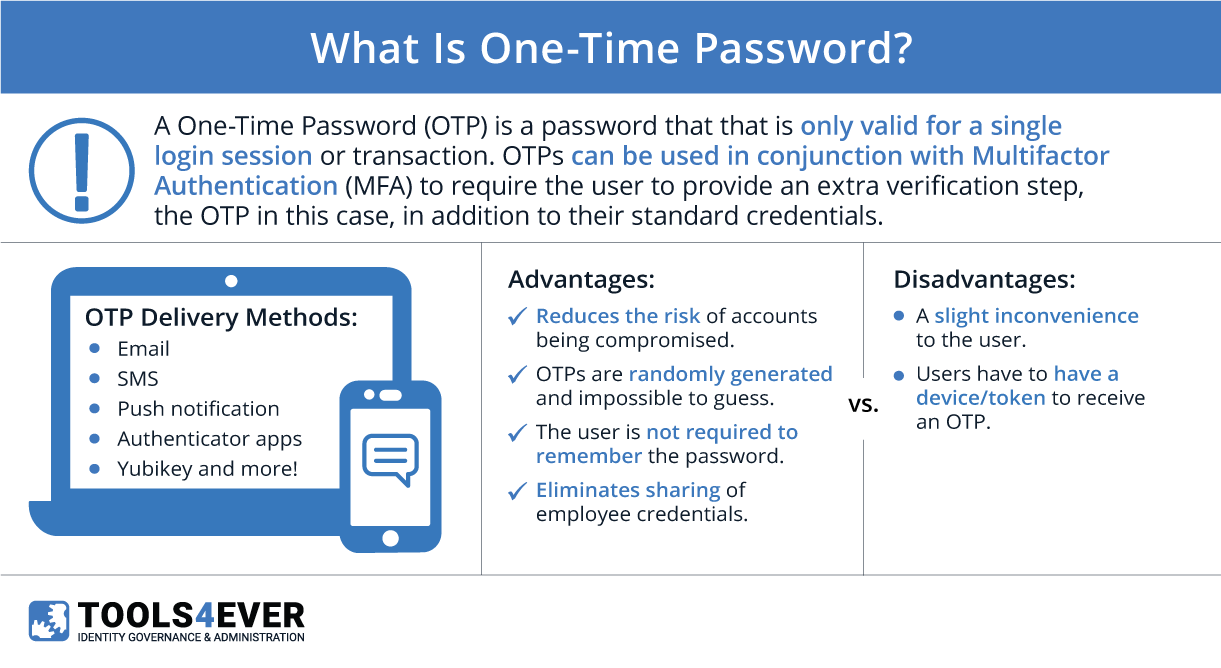An OTP (i.e., one-time password), is a password that is valid for a set duration when completing a single login session or transaction. OTPs may sometimes be called dynamic passwords, single-use passwords, or one-time PINs.
A one-time password helps to circumvent some of the drawbacks of traditional, user-created, static, or fixed passwords. It is most often combined with multifactor authentication (MFA) to add an additional security level. Otherwise, a one-time password may be used independently. OTP can replace your authentication login information altogether, or they may be used in conjunction to add another layer of security.
One-time passwords are automatically generated and expire after a certain period (e.g. every 60 seconds). When a new OTP is generated, it remains the only code valid before the next reset.
OTP Use Cases & Examples
One-time passwords may be used on their own or in conjunction with multifactor authentication.
When used independently, a user is prompted to enter some identifying information, such as an email address, telephone number, or username. The randomly generated single-use password is then sent to the user via email, SMS, push notification, or another method. Since the user should be the only person able to receive it, they can be assured that they have exclusive access to the OTP. They are then able to log in.
When the one-time password is used in conjunction with a traditional password, the user is asked to log in normally. Only after they have successfully entered their regular credentials and password would the OTP be sent or requested. In many of these instances, users are given small devices, such as a key fob or token, to generate the one-time password, which they would use to access their account. Alternatively, a user may download an OTP or “authenticator” client onto their smartphone, which displays an OTP linked to a given login process.
OTP tokens can be either event-based or time-based. Event-based tokens generate new codes at the press of a button and remain valid until used. Time-based tokens generate codes that are valid only for a certain amount of time (usually less than a minute), after which a new code is generated. These tokens are quite popular in the financial industry to ensure that users’ sensitive banking information is kept secure and reduces or eliminates the risk of unauthorized access to users’ accounts.

Advantages of One-Time Passwords
The foremost advantage of and the primary reason for OTPs is security. Since a single-use password will change with each login attempt, the risk of an account being compromised is drastically reduced, if not eliminated.
One-time passwords are randomly generated strings of characters that are virtually impossible to guess. In industries that deal with highly-sensitive private information, such as banking, one-time passwords can help to reduce the risk of fraud, while giving users peace of mind and confidence when accessing their resources.
Another advantage of this kind of password is that since it is randomly generated, the user does not have to make an effort to remember it. The OTP is always provided via an authenticator app or physical token.
Randomly-generated passwords are infinitely more secure than user-created passwords. User-created passwords are usually quite weak, with reuse across multiple accounts further decreasing security. When a password is overly simplified to make memorization easier, it typically lacks sufficiently secure complexity.
Employing one-time passwords also eliminates the sharing of credentials between employees within or, worse, external to an organization.
Disadvantages of One-Time Passwords
The main disadvantage of using one-time passwords is that some users may find it to be an inconvenience. Less tech-savvy users may, for example, see the OTP process as confusing or unnecessary, and may need an explanation of its full advantages.
A user may also be unable to access the OTP. Some emailed OTPs may be delayed or end up in a Spam folder. If a user loses a physical token, they’ve lost access to their OTP.
Many users find this frustrating or annoying, even if they understand and appreciate the security benefits of using one-time passwords. Some users prefer using mobile applications on their smartphones that generate one-time passwords for this reason. While users are likely to forget their key fob or token, they are bound to have their smartphones on them.
OTP: A Proven Method for Increasing Security
Ultimately, one-time passwords are a proven method of increasing security and reducing compromised accounts, fraud, and other cybercrime. Despite the additional effort that is often required to utilize this method, most users strongly agree that this is a small price to pay for the security and peace of mind that comes with using one-time passwords.
